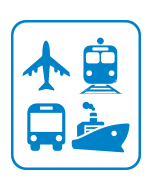Global Transportation and Logistics Industry Outlook, 2019
Global Transportation and Logistics Industry Outlook, 2019
Increased Demand for Integrated Supply Chain, Adoption of Digital Technologies in Freight and Warehouse Management, Innovations in Urban Logistics and Last-mile Delivery Solutions Will Drive Logistics Industry Growth to 3.8% in 2019
13-May-2019
North America
Description
The global economic environment for 2018 faced headwinds due to trade wars, higher oil import costs, and interest rate hikes. The growth of the global economy in 2019 will be subdued, as trade tensions remain elevated, with emerging markets experiencing substantial financial market pressures. The global trade slowdown, further fuelled with capacity and cost pressure and regulatory compliance, concerns logistics industry participants.
In 2019, shipping lines will prepare in large for compliance with the IMO 2020 sulfur regulations, impacting contract terms, demolition of fuel-inefficient vessels, disruptions in vessel deployment, and fuel surcharge structures. Industry consolidation is likely to continue with strategic alliances and mergers to facilitate operations at reduced costs through asset sharing. Slowdown in world trade is expected hit air the cargo market’s volume growth and yield performance, as freight capacity growth is expected to outstrip demand due to weakened consumer confidence. Rail freight is expected to gain traction, supported by infrastructure development and regional rail network expansion with increased deployment of transfer hubs powering inter-modal transportation. Tightened capacity, scarcity of workforce due to demographic imbalance, stringent emission regulations, and increasing fuel cost will pose significant challenges for road freight transportation. However, to second sustainability, penetration of emission-free vehicles for long-haul transportation and last-mile deliveries is expected in 2019.
In 2019, logistics industry majors across the value chain are expected to prioritize operational efficiencies, with investments in technology adoption. Freight forwarders that offer innovative online solution offerings in freight matching, custom brokerage, and transportation management solutions are expected to transform the segment with enhanced customer experience. The warehousing industry is expected transform significantly with process automation due to the emergence of cross-border eCommerce and increasing demand for integrated supply chain solutions. Rapid growth in the eCommerce market would intensify competition among eCommerce logistics solution providers. Innovation in order fulfillment, delivery models, and value-added services is expected to reshape the last-mile delivery segment.
Research Highlights
This study analyzes these various trends and provides the 2019 growth outlook for the global transportation and logistics industry in terms of size, by region and by industry segments, such as freight transportation, covering ocean freight, air freight, and overland freight; warehousing; freight forwarding; and Courier, Express, and Parcel (CEP) services. It also covers the stature of technology concepts, infrastructure trends, and opportunities relating to Industry 4.0, emission regulations, cross-border trade, infrastructure modernization, and industry digitalization and their implications for logistics and supply chain service providers. The specific digital technologies covered include Blockchain, augmented reality, data analytics, drone technologies, Internet of Things (IoT) robotic systems, and 3D printing. This research also identifies the potential disruptive impact of these technologies on logistics segments and predictions concerning freight transportation inefficiencies, urban logistics, emerging business models with IT platforms that enhance process transparency, and supply chain visibility.
Author: J Sivan
RESEARCH: INFOGRAPHIC
This infographic presents a brief overview of the research, and highlights the key topics discussed in it.Click image to view it in full size

Table of Contents
Executive Summary—Key Highlights of 2018
Executive Summary—Top Trends for 2019
Executive Summary—Industry Size by Region and Segments
Executive Summary—Industry Growth by Region
Executive Summary—Outlook by Logistics Segments
Executive Summary—Logistics Technologies and Segments
Executive Summary—Stature of Technology Concepts in Global Logistics
Executive Summary—Opportunities With Digital Technologies
Executive Summary—Opportunities With Digital Technologies (continued)
Key Findings—Top Predictions for 2019
Key Findings—Top Predictions for 2019 (continued)
Research Scope
Logistics Industry Segments
Research Aim and Objectives
Key Questions This Study Will Answer
Research Background
Top 2018 Global Economic Trends
Top 2019 Global Economic Predictions
Top 2019 Global Economic Predictions (continued)
Top 2019 Predictions—Advanced Economies
Top 2019 Predictions—Emerging Economies
World GDP Growth Snapshot
World’s 20 Fastest Growing Economies in 2018 and 2019
Logistics Industry Segments
Top 5 Markets by Size in 2019
Regional Market—North America
Regional Market—Latin America
Regional Market—Europe (G5 Versus E5)
Regional Market—Russia and CIS
Regional Market—China and India
Regional Market—APAC
Regional Market—The Middle East
Regional Market—Africa (North Africa and Sub-Saharan Africa)
Major Logistics Service Providers
New Product/Technology/Service Launches 2019
Industry Segment Outlook—Freight Transportation and Warehousing
Industry Segment Outlook—Freight Forwarding and CEP Market
Air Freight—Traffic Flow
Air Freight—Trade Route and Hubs
Air Freight—Regional Outlook
Ocean Freight—Container Throughput
Ocean Freight—Trade Flow and Trans-shipment Hubs
Overland Freight Transportation—Road and Rail Freight Markets
Key 2019 Transportation and Logistics Industry Trends
Trends That Will Alter Inter-regional Trade Flow
Trends With Overland Freight Transportation
Trends Aiding Road Freight Market
Ocean Freight Market Trends
Industry Regulations—Measures for Emissions and eMobility
Infrastructure—Trans-Eurasia Connectivity
Emergence of New Routes and Logistics Hubs
Infrastructure—Trans-European Transport Network (TEN-T)
Infrastructure—Cross-border eCommerce Logistics Hubs
eCommerce—Logistics Value Chain
eCommerce—Online Store Operators
Cross Border eCommerce—High Growth Performance Across Regions
Business Models—Emerging eCommerce Models
Emerging Service Models in the Logistics Industry Value Chain
Business Models—eCommerce Logistics
Business Models—Courier, Express, and Parcel Segment
Business Models—Future of Storage and Warehousing
Disruptive Innovations
Supply Chain and Logistics Technologies
Blockchain—Impact on the Logistics Industry
Case Study—Blockchain Enhancing Port Connectivity for a UK Major
Case Study—Blockchain Platform Powering Saudi’s Customs Operation
IoT in Logistics Industry—Future for Autonomous Intelligence
Case Study—Real-time Container Monitoring
Urban Last-mile Innovation Factors
Drone Applications in Logistics Industry
Last-mile Sustainability Measures
Case Study—DHL-StreetScooter GmbH
Case Study—Last-mile Delivery: Future Generation Delivery Van
Case Study—Shared Micro-depots
3D Printing—Gearing for Virtual Warehouses
Case Study—3D Printing Technology
Augmented Reality—Enhanced Value Addition
Case Study—Augmented Reality in Logistics
Robotics—Scaling the Need for Automation
Case Study—Robots as Colleagues
Data Analytics in Logistics—The Next Frontier
Big Data to Create Unlimited Opportunities for Logistics providers
Case Study—Data Analytics Uncapping the Potential for Optimization
Logistics 4.0—Industry Transformation
Impact of Digital Technologies in the Logistics Ecosystem
Growth Opportunity—Logistics Services
Strategic Imperatives for Success and Growth
The Last Word
Legal Disclaimer
Abbreviations and Acronyms Used
Market Engineering Methodology
List of Exhibits
List of Exhibits (continued)
List of Exhibits (continued)
List of Exhibits (continued)
Popular Topics
Research Highlights
This study analyzes these various trends and provides the 2019 growth outlook for the global transportation and logistics industry in terms of size, by region and by industry segments, such as freight transportation, covering ocean freight, air freight, and overland freight; warehousing; freight forwarding; and Courier, Express, and Parcel (CEP) services. It also covers the stature of technology concepts, infrastructure trends, and opportunities relating to Industry 4.0, emission regulations, cross-border trade, infrastructure modernization, and industry digitalization and their implications for logistics and supply chain service providers. The specific digital technologies covered include Blockchain, augmented reality, data analytics, drone technologies, Internet of Things (IoT) robotic systems, and 3D printing. This research also identifies the potential disruptive impact of these technologies on logistics segments and predictions concerning freight transportation inefficiencies, urban logistics, emerging business models with IT platforms that enhance process transparency, and supply chain visibility.
Author: J Sivan
| No Index | No |
|---|---|
| Podcast | No |
| Author | Sivan J |
| Industries | Transportation and Logistics |
| WIP Number | PA67-01-00-00-00 |
| Is Prebook | No |
| GPS Codes | 9800-A6,9B01-A6,9674-A6,9694,9968-A6,9965-A6,9AF6-A6 |
 USD
USD GBP
GBP CNY
CNY EUR
EUR INR
INR JPY
JPY MYR
MYR ZAR
ZAR KRW
KRW THB
THB




